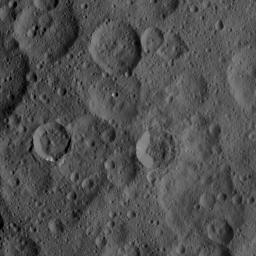
|
Dawn HAMO Image 54
- Click the image above for a larger view
- Full-Res JPEG (1024 x 1024) (152.7 kB)
- Full-Res TIFF (1024 x 1024) (1.1 MB)
Caption:
This image of Ceres, taken by NASA's Dawn spacecraft, shows a densely cratered region centered at 48 degrees north latitude, 286 degrees east longitude. The craters in the image are characterized by different degrees of freshness, reflecting different ages. The sharply defined crater to right of center is named Takel, after the Malaysian goddess in charge of the tuber harvest. Takel has a diameter of 13 miles (21 kilometers) and features a narrow tongue-like deposit extending outward from its lower rim.
Dawn took this image on Oct. 1, 2015, from an altitude of 915 miles (1,470 kilometers). It has a resolution of 450 feet (140 meters) per pixel.
Background Info:
Dawn's mission is managed by JPL for NASA's Science Mission Directorate in Washington. Dawn is a project of the directorate's Discovery Program, managed by NASA's Marshall Space Flight Center in Huntsville, Alabama. UCLA is responsible for overall Dawn mission science. Orbital ATK, Inc., in Dulles, Virginia, designed and built the spacecraft. The German Aerospace Center, the Max Planck Institute for Solar System Research, the Italian Space Agency and the Italian National Astrophysical Institute are international partners on the mission team. For a complete list of acknowledgments, see http://dawn.jpl.nasa.gov/mission .
For more information about the Dawn mission, visit http://dawn.jpl.nasa.gov .
Cataloging Keywords:
| Name | Value | Additional Values |
|---|---|---|
| Target | 1 Ceres | |
| System | Main Belt | |
| Target Type | Dwarf Planet | Asteroid |
| Mission | Dawn | |
| Instrument Host | Dawn | |
| Host Type | Orbiter | |
| Instrument | Framing Camera (FC) | |
| Detector | ||
| Extra Keywords | Crater, Grayscale | |
| Acquisition Date | ||
| Release Date | 2015-11-06 | |
| Date in Caption | 2015-10-01 | |
| Image Credit | NASA/JPL-Caltech/UCLA/MPS/DLR/IDA | |
| Source | photojournal.jpl.nasa.gov/catalog/PIA19997 | |
| Identifier | PIA19997 | |
